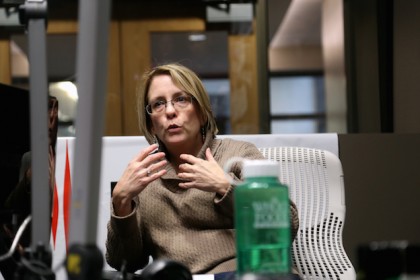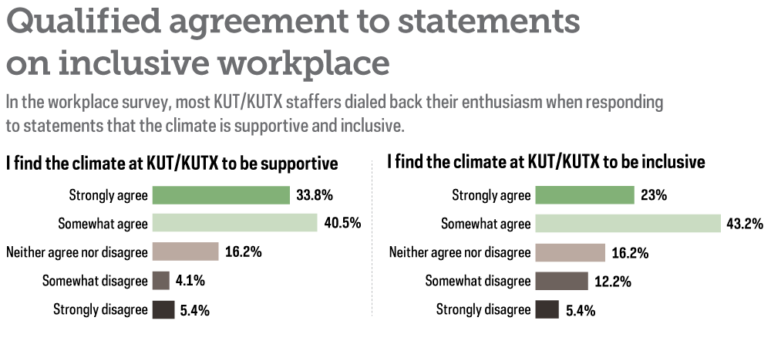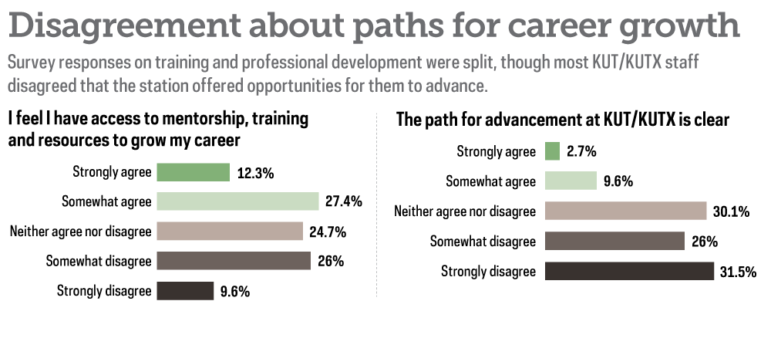Austin’s KUT wrestles with ‘serious issues’ in newsroom culture

Gabriel C. Pérez
KUT's headquarters in Austin.
Before KUT GM Stewart Vanderwilt left Austin, Texas, he would set in motion a plan to change the culture of the newsroom he presided over for 18 years.
The effort was made partly in response to the organizing efforts of a dozen journalists of color who met with Vanderwilt privately in January. At the meeting they discussed their concerns around staff retention, diversity and career growth, according to four journalists who attended the meeting.
“There’s not really a route or a method for seeking new opportunities, or better opportunities, for people of color; whereas a lot of my white colleagues have been promoted, sometimes several times, since I’ve been here,” said Ashley Lopez, a Latina reporter who joined the KUT newsroom in January 2016 and organized the meeting.
Some also discussed what they described as a legacy of mistreatment of newsroom employees, lamenting that Emily Donahue, KUT’s first news director and former executive producer of its daily newsmagazine, still worked at the station in a fundraising role. It’s painful to still see her around, they told Vanderwilt, according to news staffers who attended the meeting.
“One person choked up” while discussing his past experiences with Donahue, Lopez said. The employee who broke down confirmed Lopez’s description of his emotional reaction, as did two other attendees. “You could tell there was a lot of trauma there, a lot of baggage,” Lopez said.

Jorge A. Sanhueza-Lyon
Vanderwilt
Vanderwilt listened. He made no firm commitments, according to Lopez and three other attendees. Vanderwilt described the meeting to Current positively but declined to discuss it in detail.
Vanderwilt followed up with the group in March with an email describing “next steps to strengthen our atmosphere, team, approach and public service.” But Vanderwilt won’t be around to see those changes through. In July he began a new job as president of Colorado Public Radio.
Under Vanderwilt’s leadership, KUT had grown into a new studio, added an all-music station, expanded its newsroom staff, launched the daily newsmagazine Texas Standard and won prestigious state, regional and national awards. When KUT began building its newsroom in 2001, then–Program Director Hawk Mendenhall recalled a vision of community service that is much like the KUT of today: strong editorial leadership overseeing a talented reporting team, a daily newsmagazine covering the state and collaborations with media partners across Texas.
KUT made impressive progress toward achieving these goals. Since the March 2015 debut of Texas Standard — created in partnership with three Texas stations and other news organizations — KUT is now aiming higher. It is at the center of NPR’s first regional news hub, a collaboration developed with NPR, Texas Public Radio in San Antonio, Houston Public Media and KERA in Dallas. Yet as Vanderwilt departed, the newsroom continued to reckon with longstanding tensions over opportunities for advancement and the difficult working conditions that current and former newsroom staffers say they endured.
Current spoke with 19 current and former KUT staffers for this story, including 12 sources who joined KUT’s expanding news operations under Donahue’s leadership, beginning in 2002 through 2016. Eight shared first-person accounts of their experiences; six more witnessed the conflicts and pressures that others struggled to work through. Many of those who described their firsthand accounts also confided in a KUT leader and an outside consultant; both spoke with Current on background because of the sensitivities of discussing workplace issues.
Much of the ongoing effort to reshape the culture of the award-winning newsroom involves close collaboration between newsroom leaders and a consultant over four visits, according to KUT leadership. Their scope of work includes changing approaches to hiring, completing a newsroom sourcing survey, examining staff diversity and convening discussions among staff and leadership about unconscious bias, goal-setting and more.
 An employee workplace culture survey, completed early in the process, found staff feel positive about working at KUT and optimistic for the future. Some KUT staffers see Vanderwilt’s departure this summer as an opportunity to change the station’s culture from the top down. Others aren’t as optimistic.
An employee workplace culture survey, completed early in the process, found staff feel positive about working at KUT and optimistic for the future. Some KUT staffers see Vanderwilt’s departure this summer as an opportunity to change the station’s culture from the top down. Others aren’t as optimistic.
“I think KUT is reflective of issues that are at a lot of stations, and actually a lot of organizations, period,” said KUT News Managing Editor Matt Largey, who did not attend the January meeting between Vanderwilt and the journalists. “If organizations don’t confront this, they can develop a reputation, and that reputation makes it harder for them to attract and retain the best talent.”
‘Too big to fail’
This is KUT’s second major go-round with newsroom consultants in four years. Vanderwilt sought guidance from public media consultants Coats2Coats to address “management structure,” among other areas, according to an email he sent the Florida-based consultancy in September 2014. (Coats2Coats has previously advised Current.)
After facilitating a staff meeting and completing one-on-one interviews with 27 staff members, the consultants summarized their findings in a July 2015 report to KUT leadership. The report described a “dysfunctional” culture at Texas Standard that was affecting editorial quality and staff morale throughout the organization, according to a copy of the report, which a KUT staffer shared with Current.

KUT, Austin
Texas Standard host David Brown listens back to a show segment.
At that time, KUT had been without a news director for two years. Donahue had ascended from news director to become EP of Texas Standard, hosted by David Brown, her husband. Largey was working in an interim leadership role as news editor. Other staff members had been assigned supervisory responsibilities that didn’t fit their core job functions, the report said.
In reporting on the site visit, Coats2Coats described how the lack of structure and accountability affected news operations. The report quoted an unnamed staff member saying there are no consequences for anything, such as missing deadlines, pushing back stories, being late or screaming at people. “There is no one who has the desire to do the hard things and be the boss,” the staffer said.
“We heard universally that the culture in Texas Standard is extraordinarily tense, beyond the tension that one would expect even given the nature of a startup operation,” the report said. “The culture operates via crisis management. Staff members report being berated and spoken to in an unprofessional manner. The greatest source of tension is the relationship between the executive producer and the host; staff members are extremely uncomfortable witnessing intensely personal, hostile interactions between them.”
Former KUT staffers and sources whose tenures long preceded Coats2Coats’ consulting work described their observations and experiences — and how it affected them professionally — in detail to Current.
Steven Cuevas, who joined KUT in 2002, described Donahue’s interactions with reporters and producers as “hostile.” “Emily had a really good ability to make you feel like you had done something wrong, even when you hadn’t — you probably had and she hadn’t caught the mistake,” Cuevas said. “It was that kind of environment she created.”
Cuevas said he and his peers talked with Vanderwilt and Mendenhall “on numerous occasions” about working conditions in the newsroom. “Was it bullying? Depends on what you would qualify as bullying,” Cuevas said. “But I would say [Donahue] was condescending; she was short with people; she was rude.”
Cuevas left KUT in 2004 immediately after a conflict with Donahue. During his exit interview with Vanderwilt, Cuevas said he reiterated his views about how Donahue’s behavior had made the KUT newsroom a miserable place to work.
Erika Aguilar, who worked at KUT between 2007 and 2012, and other former staffers said arguments between Donahue and Brown often disrupted the newsroom, with the two screaming at each other openly. When Aguilar worked at KUT, Donahue was directing KUT’s news coverage; Brown hosted the show Texas Music Matters.
Aguilar joined KUT at age 22 and said she was “deeply affected” by the tense newsroom environment. She often wondered whether she or her colleagues did something wrong.
“We know newsrooms can be intense,” Aguilar said. “When you’re on deadline, they can be hard. That doesn’t mean, though, that you can have screaming matches in the middle of the newsroom. There’s a way to resolve personal and/or work-related disputes in a more professional manner.”
The Coats2Coats report outlined implications of the damaged relationships within KUT’s news operations, pointing to “serious issues of both culture and process”:
- “The KUT Newsroom resents the focus on Texas Standard and does not want to work with leadership within that part of the organization. Questions of pay and priority for Texas Standard soured the KUT staff on that operation from the start. … And poor past experiences with Texas Standard leadership leave the KUT staff determined not to put themselves back into that difficult work environment.”
- “There is a serious lack of clarity about lines of authority and oversight for the news organization.”
- “Internal communication is broken. Communication between KUT and Texas Standard is very troubled; staff members fear they will be scolded for talking ‘over the wall’ to each other about even the most routine things.”
KUT had launched a “high-stakes effort” with Texas Standard, produced and broadcast in collaboration with stations across the state, the consultants noted in the report. “For these efforts to succeed, the organization will need strong leadership, radical clarity of mission and a powerful culture of collaboration,” the report said. “None of these elements are currently in place.”
Several months after Coats2Coats delivered that report, Donahue moved into a newly created position as director of journalism sustainability and impact, a fundraising role working directly with Vanderwilt. The new job became effective Jan. 1, 2016, according to an email Vanderwilt sent to staff Dec. 31, 2015. Vanderwilt announced other staffing changes: Largey was named managing editor for KUT news and given full responsibility for directing news coverage. New hires, including Lopez, would join the station by the end of the month.

Stephens
“The problem with the Texas Standard is we’re like a bank; we’re too big to fail,” said Alain Stephens, formerly an investigative reporter with KUT News and producer with Texas Standard. “They’ve invested so much money in it; essentially the show is bigger than the people who make it.”
Efforts to build diverse public radio newsrooms started long before the #MeToo movement roiled the news media one year ago, forcing public stations and networks to reckon with longstanding problems with sexual harassment and bullying. At KUT the movement spurred some staffers to speak up about the cumulative effects of perceived infractions that occurred over many years as news operations expanded. “It takes some time for people to be held accountable, and I think any time is the right time for that,” Lopez said.
Young journalists who worked at KUT described interactions that undercut productivity and confidence in their own professionalism.
Some recalled conversations with Donahue in which she made racially insensitive remarks to them. Aguilar recounted an exchange in which she was describing local events marking Juneteenth, including a parade that she planned to cover. Aguilar said Donahue responded, “‘Oh, you mean Black People’s Day.’”
“I was just stunned,” Aguilar said.
While interviewing Stephens for a full-time job with Texas Standard, Donahue asked a question that he paraphrased as “‘Why should I hire you — other than because you’re black?’” he recalled. “At the moment, she very much acknowledged that I’m a diversity hire right out the gate.”
In an emailed statement, Donahue denied both Aguilar and Stephens’ accounts. “Both the letter and the spirit of these assertions are untrue,” Donahue said. “I do not and never have condoned nor sat silently for anyone to say such things in my presence.”
Nearly all of the journalists interviewed by Current said they did not pursue formal complaints about Donahue because they feared retaliation. Donahue, a prominent public radio journalist, could make or break their careers, they said. Several public information requests about Coats2Coats work, Donahue and decisions behind her fundraising job yielded no complaints.

KUT
Donahue in a meeting on Texas Standard.
Donahue has declined several requests for interviews about her leadership of KUT’s newsroom and Texas Standard. A KUT spokesperson to whom she referred questions directed Current to contact a public relations officer at the University of Texas, KUT’s licensee. Donahue declined another interview request through the university but responded to questions via email.
Donahue acknowledged tensions in her relationships with staff members and with Brown in the email, characterizing them as typical for any news organization launching a new show with the ambitions of Texas Standard.
She also indicated that it was not her choice to become executive producer of Texas Standard, an assignment that involved working closely with her husband.
“It was the decision of KUT management — which I protested — to assign us to work together,” Donahue said, referring to Brown. “As to the culture of interactions between Texas Standard and the KUT newsroom, there was limited collaboration, per management, partly to ascertain whether the program could stand on its own editorially as well as financially.”
Well before Vanderwilt brought in Coats2Coats to advise him on newsroom management, Donahue was looking for a way to exit the show. According to an email obtained from a public information request, Donahue had proposed that Vanderwilt create a new position, director of news and information, and nominated herself to fill it. The new position would support the newsroom and newsmagazine to build collaborations, coordinate coverage and “prevent corrosive ‘silos’ from emerging.” Donahue shared text from the message with Coats2Coats in a June 2015 email and said she sent the proposal to Vanderwilt in 2014.
Brenda Salinas was an associate producer with Texas Standard between August 2014 and July 2015, during the time that Vanderwilt sought advice from Coats2Coats. She said news staff accepted Donahue’s antagonism as part of working for KUT. But she went to Vanderwilt, Mendenhall and human resources staff to complain. She was invited to pursue mediation. Salinas said she quit instead.
Vanderwilt and Mendenhall, who works as associate GM of broadcast and content and supervised Donahue in her newsroom jobs, told Current that they don’t discuss personnel issues. Both said they always followed university protocol to resolve staff disputes, which could include mediation or conflict resolution.

John Anderson
Mendenhall
Mendenhall said his protocol is to note inappropriate behavior in staff evaluations and ask for improvement from staff in those cases. He also notified Vanderwilt, his boss, when things “rose above the level of minor disagreements” and “asked for HR guidance in difficult personnel situations and followed the advice of our HR representatives.”
 “I have made it a point for years to encourage upset staff members — in addition to telling me — to go to HR directly with issues they experienced,” Mendenhall continued. “This is especially important when it’s one person’s word against another. When employees who were involved in a contentious situation don’t speak up for themselves directly, and don’t want to be identified to HR, it makes a supervisor’s job very, very difficult.”
“I have made it a point for years to encourage upset staff members — in addition to telling me — to go to HR directly with issues they experienced,” Mendenhall continued. “This is especially important when it’s one person’s word against another. When employees who were involved in a contentious situation don’t speak up for themselves directly, and don’t want to be identified to HR, it makes a supervisor’s job very, very difficult.”
Donahue said she was unaware of complaints made to Vanderwilt and Mendenhall about her leadership. “I am required to follow UT policy and state law with respect to any and all personnel matters, as are each and every one of KUT’s employees,” Donahue wrote.
Stephens, who participated in the January meeting with Vanderwilt, said the newsroom is still “healing from Emily Donahue. They’re trying to reverse some of her politics and make it nicer and chiller and reverse the culture. They’re trying to do more stories about people of color, trying to hire more people of color.”
The immediate fear and uncertainty of working under her has been lifted, Stephens said. “But there’s also no justice.” He opted to move onto a new job, departing KUT for inewsource in San Diego last month.
‘You still have to prove yourself’
Amy Kovac-Ashley, director of newsroom learning at the American Press Institute, is one of the consultants involved in KUT’s efforts to change its newsroom culture.
Prior to meeting with staff last month, Kovac-Ashley said she wasn’t surprised that changes in editorial leadership haven’t brought closure to staff, who are still trying to work through KUT’s organizational culture.
“The culture is not just one person’s view of how things should or shouldn’t work,” Kovac-Ashley said. “It’s all the processes and ways of interacting between one another that make up culture.”
Kovac-Ashley has been facilitating newsroom discussions, asking questions that get participants to think about working conditions that inspire their best work and to consider structures and resources they may have taken for granted. After articulating their ideas, the group will consider the steps they can take to make their ideal newsroom happen.
“In that exercise, I’m trying to give them some level of agency and control that they might not feel they have,” Kovac-Ashley said.
Any time there are negative emotions about what happens in workplace settings, those feelings don’t just magically go away, Mendenhall said. “You still have to prove yourself in any situation every day that you’re working to make things better.”
Mendenhall stressed KUT’s commitment to building a diverse journalistic organization, noting that KUT, like most organizations, can improve on its efforts to develop and empower talent.
 Like most newsrooms, the diversity of journalists on KUT’s staff doesn’t reflect the demographics of its community. In Austin and the state of Texas, whites became a minority in 2012, according to U.S. Census Bureau figures. Hispanic journalists have held a wider range of positions than other journalists of color, but none has ascended into a job higher than senior producer, according to data KUT reported to CPB between 2010 and 2017. Those higher-level newsroom job categories include roles such as executive producer, editor, senior editor, managing editor, assistant news director and news director. CPB’s methodology for tracking the diversity of newsroom contributors logs the race and gender of those who work full-time, part-time and as contractors to produce local coverage.
Like most newsrooms, the diversity of journalists on KUT’s staff doesn’t reflect the demographics of its community. In Austin and the state of Texas, whites became a minority in 2012, according to U.S. Census Bureau figures. Hispanic journalists have held a wider range of positions than other journalists of color, but none has ascended into a job higher than senior producer, according to data KUT reported to CPB between 2010 and 2017. Those higher-level newsroom job categories include roles such as executive producer, editor, senior editor, managing editor, assistant news director and news director. CPB’s methodology for tracking the diversity of newsroom contributors logs the race and gender of those who work full-time, part-time and as contractors to produce local coverage.
 Last month the station held a Next Generation Radio program, a weeklong digital journalism training for college students and early-career professionals led by Doug Mitchell, the consultant who is working with KUT on its larger effort to change its workplace culture. The station has hired top performers from its last two Next Generation projects.
Last month the station held a Next Generation Radio program, a weeklong digital journalism training for college students and early-career professionals led by Doug Mitchell, the consultant who is working with KUT on its larger effort to change its workplace culture. The station has hired top performers from its last two Next Generation projects.
Largey, now KUT’s managing editor, acknowledged that KUT’s culture was dysfunctional for a time. But he and others agreed it has improved with new hires and efforts to help people feel valued. The station’s latest consultant-led project will help too.

Jorge Sanhueza-Lyon/KUT
Largey
“I’m hoping that at the end of this, we can have a way to measure how we’re doing in terms of inclusivity and diversity in our coverage, and also get a better sense of … how we can improve the internal culture, particularly for staff members of color,” Largey said.
Lopez, who organized the meeting between Vanderwilt and the journalists, is more cautious. “I’m glad that they’re getting outside help,” she said. It was clear that top leadership weren’t able to deal with the problems on their own, she added. “We’ll have to see what comes out of this. I’m watching closely.”
Lopez wants to know that KUT is a place that supports career growth. “The reason I’m trying to push people to change is because I think it has a lot of potential,” Lopez said. “They did make the first effort to bringing a lot of talented people of color here. That is the first step. And a lot of stations haven’t taken that step.”
“In general, I do like it here,” Lopez said. “But I want it to be better.”






You seem to kinda gloss over the fact that Donahue was promoted rather than fired for her obvious role in poisoning the culture of the newsroom. It’s yet another example of “failing upwards” for a certain priviliged set of people in America.
I would have liked to see this dynamic explored a little more.
I am thankful for April’s story and her diligent reporting. I’m happy to have shared with her at length my experience between 2002-2004 as one of KUT’s ‘founding’ reporters. Mr. Gowenlock’s comment above is spot on. Donahue was in a sense rewarded for her abusive, toxic leadership. Blaming her own bad behavior on the circumstances sure sounds like typical Emily to me; total lack of accountability. It’s always someone or something else. Don’t believe your lying eyes. Likewise for the managers who should have, and could have, but failed to effectively discipline – or remove – her.
In the years since I rarely though of KUT as my own career hummed along at other bigger stations. I have never, not once, encountered anything or anyone remotely as toxic in a newsroom setting in the years since – mainly because it would never be tolerated. Not only was it tolerated at KUT, it was rewarded quite handsomely despite the years of damage it caused. When I finally had enough and resigned back in 2004 I told Vanderwilt he’d continue to have problems unless he acted. I think April’s reporting lays bare in the starkest terms what happened because of that inaction. I’m saddened to hear that so many other news staffers had to deal with same.
I strongly believe the KUT newsroom could and should have soared a lot higher, a lot sooner had there been competent, strong newsroom leadership in place. The KUT staff and certainly KUT listeners and donors surely deserve(d) much better.
Emily Donahue is an honest, highly intelligent, accomplished, and tough-as-nails news editor. She’s also a tyrant who could make The Rock quiver in his boots. But why are we reading about this 17 years later? Nice timing on GM Stewart Vanderwilt’s part to at least begin to address the issue. I believe a local, community-based media, arts and cultural information organization can only grow and thrive with the absence of inflated wages and overpaid mgmt. Without the hard work, dedication, and creativity of numerous employees over the years in both the KUT newsroom and on-air, PD Hawk Mendenhall and Vanderwilt’s track record of accomplishments would be next to nothing.